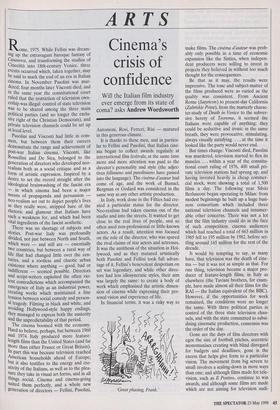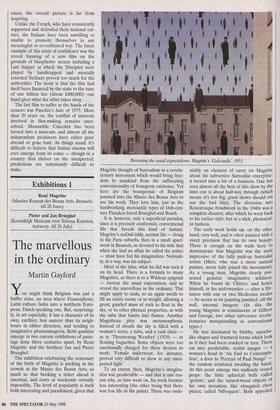ARTS
Cinema's crisis of confidence
Will the Italian film industry ever emerge from its state of coma? asks Andrew Wordsworth Rome, 1975. While Fellini was dream- ing up the extravagant baroque fantasy of Casanova, and transforming the studios of Cinecitta into 18th-century Venice, three events occurred which, taken together, may be said to mark the end of an era in Italian cinema. In November Pasolini was mur- dered; four months later Visconti died; and in the same year the constitutional court ruled that the restriction of television own- ership was illegal: control of state television was to be shared among the three main political parties (and no longer the exclu- sive right of the Christian Democrats), and private television channels could be set up at local level.
Pasolini and Visconti had little in com- mon, but between them their careers demonstrate the range and achievement of post-war Italian cinema. Visconti, like Rossellini and De Sica, belonged to the generation of directors who developed neo- realism both as a social critique and as a form of artistic expression. Inspired by a desire to set the record straight after the Ideological brainwashing of the fascist era — in which cinema had been a major means of propaganda and persuasion — neo-realism set out to depict people's lives as they really were, stripped bare of the rhetoric and glamour that Italians have such a weakness for, and which had been vital ingredients of the fascist aesthetic. There was no shortage of subjects and stories. Post-war Italy was profoundly divided, not just between North and South, which were — and still are — essentially two countries, but between a rural way of life that had changed little over the cen- tunes, and a rootless and chaotic urban existence where anything — good, bad or indifferent — seemed possible. Directors and script-writers exploited the often vio- lent contradictions which accompanied the emergence of Italy as an industrial power, creating works which maintained a fine tension between social comedy and person- al tragedy. Filming in black and white, and avoiding Hollywood-style happy endings, they managed to express both the austerity and the unpredictability of that period. The cinema boomed with the economy. Hard to believe, perhaps, but between 1960 and 1974 Italy produced more feature- length films than the United States (and far more than either France or Great Britain). In part this was because television reached American households ahead of Europe; but .it also testifies to the energy and cre- ativity of the Italians, as well as to the plea- sure they take in visual art forms, and in all things social. Cinema and cinema-going suited them perfectly, and a whole new generation of directors — Fellini, Pasolini, Antonioni, Rosi, Ferreri, Risi — matured in this generous climate.
It is thanks to these men, and in particu- lar to Fellini and Pasolini, that Italian cine- ma began to collect awards regularly at international film festivals; at the same time more and more attention was paid to the director's personality and style (the adjec- tives felliniano and pasoliniano have passed into the language). The cinema d'auteur had come of age, and the work of Bunuel, Bergman or Godard was considered in the same way as any other artistic production.
In Italy, work done in the Fifties had cre- ated a particular status for the director. Neo-realism had taken cinema out of the studio and into the streets. It wanted to get close to the real lives of people, and so often used non-professional or little-known actors. As a result, attention was focused on the role of the director, who was spared the rival claims of star actors and actresses. It was the antithesis of the situation in Hol- lywood, and as they matured artistically both Pasolini and Fellini took full advan- tage of it. Fellini's benevolent despotism on set was legendary, and while other direc- tors had less idiosyncratic styles, their aim was largely the same: to create a body of work which emphasised the artistic dimen- sion of cinema while expressing their per- sonal vision and experience of life.
In financial terms, it was a risky way to `Great phasing Frank' make films. The cinema d'auteur was prob- ably only possible in a time of economic expansion like the Sixties, when indepen- dent producers were willing to invest in projects they believed in without too much thought for the consequences.
Be that as it may, the results were impressive. The tone and subject-matter of the films produced were as varied as the quality was consistent. From Ancient Rome (Satyricon) to present-day California (Zabriskie Point), from the masterly charac- ter-study of Death in Venice to the subver- sive heresy of Teorema, it seemed the Italians were capable of anything: they could be seductive and ironic in the same breath, they were provocative, stimulating, always visually satisfying . . . at the time it looked like the party would never end.
But times change: Visconti died, Pasolini was murdered, television started to flex its muscles . . within a year of the constitu- tional court ruling of 1976, 400 small pri- vate television stations had sprung up, and having invested heavily in cheap commer- cial stock, were showing a total of 1,500 films a day. The following year Silvio Berlusconi began operating in Milan: from modest beginnings he built up a huge busi- ness consortium which included three national television channels and innumer- able other concerns. There was not a lot that the film industry could do in the face of such competition: cinema audiences which had reached a total of 663 million in 1965 fell to 195 million by 1982, before set- tling around 165 million for the rest of the decade.
It would be tempting to say, as many have, that television was the death of cine- ma — but it was not as simple as that. For one thing, television became a major pro- ducer of feature-length films, in Italy as elsewhere (the Taviani brothers, for exam- ple, have made almost all their films for the RAI — the Italian equivalent of the BBC). However, if the opportunities for work remained, the conditions were no longer the same. With three political parties in control of the three state television chan- nels, and with the state committed to subsi- dising cinematic production, consensus was the order of the day.
Gone are the days of film directors with egos the size of football pitches, eccentric monomaniacs creating with blind disregard for budgets and deadlines; gone is the excess that helps give form to a particular vision. The movement from big screen to small involves a scaling-down in more ways than one; and although films made for tele- vision, such as Il Postino, continue to win awards, and although some films are made which are not aiming for television audi- ences, the overall picture is far from inspiring.
Unlike the French, who have consistently supported and defended their national cul- ture, the Italians have been unwilling or unable to promote themselves in any meaningful or co-ordinated way. The latest example of this crisis of confidence was the recent banning of a new film on the grounds of blasphemy: scenes including a Last Supper at which the Disciples were played by handicapped and mentally retarded Sicilians proved too much for the authorities. The irony is that the film had itself been financed by the state to the tune of one billion lire (about £400,000): one hand gives what the other takes away . . .
The last film to suffer at the hands of the censors was Pasolini's Salo of 1975. More than 20 years on, the conflict of interests involved in film-making remains unre- solved. Meanwhile Cinecitta has been turned into a museum, and almost all the independent producers have either gone abroad or gone bust. As things stand, it's difficult to believe that Italian cinema will ever emerge from its coma — though in a country that thrives on the unexpected, predictions are notoriously difficult to make.



































































 Previous page
Previous page